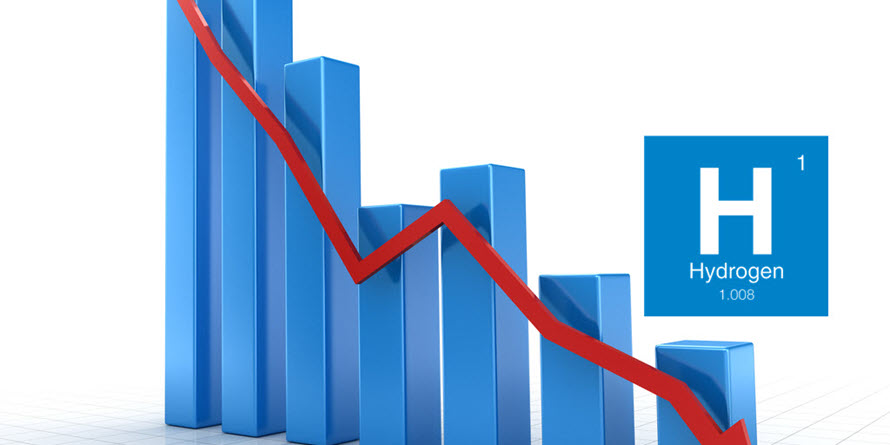
A new study by BNEF forecasts the costs of renewable hydrogen.
The research offers some important findings for hydrogen producers and consumers around the world, as well as for coal and gas companies:
- Green hydrogen can be cheaper than natural gas: We find that ‘green’ hydrogen from renewables should get cheaper than natural gas (on an energy-equivalent basis) by 2050 in 15 of the 28 markets we modeled, assuming scale-up continues. These countries accounted for one-third of global GDP in 2019.
- ‘Blue’ hydrogen undercut by green: In all of the markets we modeled, ‘green’ hydrogen should get cheaper than both ‘blue’ hydrogen (from fossil fuels with carbon capture and storage – CCS) and even polluting ‘grey’ hydrogen from fossil fuels without CCS.
- 85% cost decline coming: The costs of producing ‘green’ hydrogen from renewable electricity should fall by up to 85% from today to 2050, leading to costs below $1/kg ($7.4/MMBtu) by 2050 in most modeled markets.
- Cheaper solar behind the decline: The above costs are 13% lower than our previous 2030 forecast and 17% lower than our old 2050 forecast. Falling costs of solar PV are the key driver behind the reduction. We now think that PV electricity will be 40% cheaper in 2050 than what we had thought just two years ago, driven by more automatic manufacturing, less silicon and silver consumption, higher photovoltaic efficiency of solar cells, and greater yields using bifacial panels.
Martin Tengler, lead hydrogen analyst at BloombergNEF commented:
“Such low renewable hydrogen costs could completely rewrite the energy map. It shows that in future, at least 33% of the world economy could be powered by clean energy for not a cent more than it pays for fossil fuels. But the technology will require continued government support to get there – we are at the high part of the cost curve now, and policy-supported investment is needed to get to the low part.”
“By 2030, it will make little economic sense to build ‘blue’ hydrogen production facilities in most countries, unless space constraints are an issue for renewables. Companies currently banking on producing hydrogen from fossil fuels with CCS will have at most ten years before they feel the pinch. Eventually those assets will be undercut, like what is happening with coal in the power sector today.”
“On one hand the reduction in the forecast was surprising, on the other hand not. This is how it goes with clean energy. Every year it gets cheaper, faster than anyone expects. The key driver is the falling cost of solar PV electricity. We now think solar PV power will be 40% cheaper by 2050 than what we had thought just two years ago.”
1H 2021 Hydrogen Levelized Cost Update
The levelized cost of hydrogen (LCOH2) made from renewable electricity is set to fall faster than we previously estimated, driven by a downward revision in our forecast for solar PV electricity costs. Renewable hydrogen should now cost less than H2 made from natural gas with carbon capture and storage in all modeled markets by 2030. This report presents our updated view of renewable hydrogen costs.
- Our renewable H2 cost forecast is 13% lower in 2030 than in our previous outlook, and 17% lower in 2050. Costs fall well below $2/kg by 2030 and well below $1/kg by 2050 in most markets.
- By 2030, hydrogen from PV or onshore wind power should cost less than H2 made from natural gas with carbon capture and storage (CCS) in all 28 countries modeled.
- Renewable H2 should outcompete H2 made from natural gas without CCS by 2050 in all 28 modeled countries, and would even cost less than natural gas on an energy-equivalent basis in 15 of these markets.
- Our updated forecast on the levelized cost of renewable electricity (LCOE) is the main driver of the drop in our LCOH2 projection. We expect the average levelized cost of solar PV to be 40% lower by 2050 than we did two years ago.
- The cost of electricity will account for the majority of the cost of producing renewable H2 by 2030, with electrolyzer-related costs accounting for the rest. By 2050, the share of LCOH2 driven by electricity should approach 90% when made from onshore wind.
- BNEF’s LCOH2 analysis covers 627 modeled projects in 28 markets. All inputs and LCOH2 results are available in BNEF’s Hydrogen Project Valuation (H2Val) Model.
Read the most up to date Fuel Cell and Hydrogen Industry news at FuelCellsWorks




